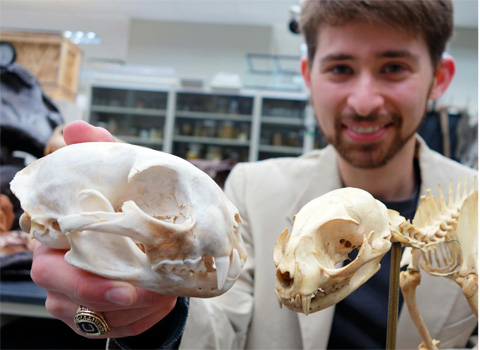Excerpts from Compass article by Angelita Faller
In honor of Homecoming—and Ohio University’s beloved mascot Rufus the Bobcat—Dr. Lawrence Witmer and Biological Sciences doctoral student Don Cerio get inside the head of—a bobcat.
It is Rufus’ 54th anniversary after all.
Witmer and Cerio present the Visible Interactive Bobcat, a website with free, downloadable 3D PDFs and YouTube videos displaying the bobcat’s skull and soft tissue anatomy.
Where Did Rufus Get His Name?
“We thought it was a great choice to do some science on the animal that actually represents us as a university. The bobcat is endangered in Ohio, so it makes sense for us to learn more about the animal our university has been so associated with. A lot of people don’t know that Rufus is part of the scientific name for the animal, Lynx rufus,” said Witmer, a professor of anatomy in the Heritage College of Osteopathic Medicine.
Witmer’s team is best known for its work on the Visible Interactive Dinosaur project, which creates 3D visualizations of the soft tissue anatomy in the skulls of animals, particularly dinosaurs. The Visible Interactive Bobcat is the seventh project in the WitmerLab’s Visible Interactive Anatomy series, which is funded by a National Science Foundation grant.
How Many X-rays Did It Take to Make a Bobcat?
Witmer’s team uses the university’s microCT scanner to reconstruct the skull and soft tissue anatomy of animals. For the latest project, the microCT scanner took more than 1,500 X-rays of the bobcat’s skull to create the virtual 3D image.
Studying the skull anatomy of live animals can help scientists understand the anatomy of extinct animals. The tooth structure of a bobcat, a carnivore, can give scientists a sense of how the tooth structure of other carnivores, such as a Tyrannosaurus rex, work.
The adult bobcat that served as the star of the Visible Interactive Bobcat project was a resident of Athens County who was donated to the university by the Ohio Department of Natural Resources.
“It was a road kill victim, as evidenced by some skull fractures visible in the imagery,” write the researchers, who note the resources on the Visible Interactive Bobcat website are “outgrowths of our more technical work and are intended to serve as STEM educational aids for K-12 and undergraduate students, as well as for researchers.”
“I’ve really developed a new appreciation for this animal. It’s sad that this particular animal died, but the fact that we can get so much information out of it, compare it with extinct animals as well as modern day animals, and learn about their anatomy is really cool,” Cerio said.




















Comments